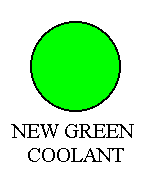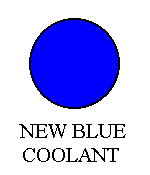Checking Your Coolant
*VERY EASY*
Coolant plays a vital role in the operation of your engine. To help ensure that your engine will not fail, check the coolant each month as follows:
- Park the vehicle on level ground in a well-ventilated area with the engine OFF, the parking brake engaged, and the transmission in PARK (for automatic) or REVERSE (for manual). The coolant level can be checked with engine hot or cold; in either case, the engine must be off to obtain an accurate reading. If checking the coolant level with a hot engine, make sure the engine reaches full operating temperature first. Raise the hood to perform the check.
- Consult your owner's manual to identify the location of your coolant recovery reservoir. It is usually a clear plastic container located immediately behind the radiator toward the front of the engine compartment. It is connected to the radiator filler neck with a rubber hose.
- Observe the coolant level in the recovery reservoir compared to the HOT (or MAXIMUM) and COLD (or MINIMUM) marks imprinted on the side of the reservoir. The coolant level should be at or above the HOT mark when it is hot. If the engine and coolant are cold, the fluid should be at or above the COLD mark.
- Remove the recovery reservoir cap to clearly observe the condition of the
coolant. If the radiator is hot, be careful not to burn yourself. The coolant
should be light green in color and should smell sweet. Note that some modern
coolants are dark blue. Feel it with your fingers if possible; it should feel
slippery. If your coolant is brown or rusty or smells sour, it must be changed.
If the engine is cold, the radiator cap can be removed for further coolant inspection. If a heavy film exists inside the filler neck opening of the radiator, the coolant must also be changed. - If the coolant level in the recovery reservoir is inadequate, prepare some coolant (antifreeze mixture) as specified in your owner's manual. Most likely, you should prepare the mixture in a separate container, like a plastic milk container, by combining a high quality, nationally advertised antifreeze with room temperature tap water in a 50/50 ratio by volume. Shake the mixture well. Use distilled water if your tap water is "hard" (has high mineral content) or has a high alkaline content, otherwise rust or scale might form inside your cooling system. The rust and scale will coat the cooling system and prevent the full release of heat. Furthermore, the deposits can damage your water pump.
- Add the fresh coolant up to the appropriate mark, if necessary, by using a funnel. Close the recovery reservoir cap. Be sure the coolant recovery reservoir hose is connected to the radiator.
- If the radiator is on an older car, there may not be a coolant recovery reservoir. In this case, check the coolant level only when the engine is cold. Remove the radiator filler cap and view the level of coolant inside the radiator. It should be about 2" below the bottom of the radiator filler neck to allow room for expansion when the coolant gets hot. Use a funnel to add coolant directly to the radiator if necessary. Replace the radiator cap.
- Close the hood. Keep a record of the quantity of additional coolant used and the vehicle's mileage at which it was added. A cooling system should consume little, if any, coolant. In other words, periodic cold checks should consistently indicate one level while periodic hot checks should consistently reveal another higher level. If coolant must be added more frequently than once each month, it is leaking or being burned inside the engine. Use your maintenance records to determine if your car needs cooling system service by a professional automotive technician.


